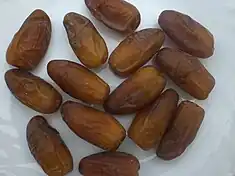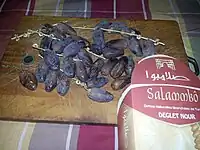| Deglet Nour | |
|---|---|
 | |
| Genus | Phoenix |
| Species | Phoenix dactylifera |
| Origin | Tolga, Algeria |


Deglet Nour, also spelled Deglet Noor (Modern Arabic: دقلة نور; from Classical Arabic دقْلَة النُور daqlatu (a)n-nūr, literally, "date-palm of light", "heavenly date"; from Classical Arabic دقل daqal, a kind of date palm), is a cultivar of the date palm that originated in the oasis of Tolga in Algeria.[1][2] Commonly referred to as the "queen of all dates",[3] the authentic Algerian[4] Deglet Nour date has a soft touch, a translucent light color and a honey-like taste, characteristics which distinguish it from other dates.
Deglet Nours are popular in Algeria, Libya and Tunisia, where they are grown in inland oases and are the chief export cultivar. Deglet Nour is one of hundreds of cultivars of the date palm but is, according to the Food and Agriculture Organization of the United Nations (FAO), the leading date in terms of export value.[5]
Origins
Several old works provide evidence that the Deglet Nour date was first grown in Algeria. Among them are Le palmier-dattier (The Date-Palm) by Pierre Munier, L'Algérie: un siècle de colonisation française (Algeria: A Century of French Colonization) by Félix Falck, Un voyage au pays des dattes (A Trip to the Land of Dates) by Jean-Henri Fabre, and le Bulletin de la Société botanique de France (Bulletin of the French Botanical Society). Munier states that the fruit was introduced at the end of the 13th century and the beginning of the 14th century from the oasis of Tolga to the neighboring areas of Biskra and Oued Righ in Algeria, before being brought to Tunisia at the end of the 17th century by a grower from Tozeur named Sidi Touati.[2]
The Algerian Ministry of Agriculture has decided to act to reserve commercial usage of the Deglet Nour label for Algerian dates.[6]
Production
This cultivar of date is grown mainly in Algeria (Tolga, Oued Righ), in Tunisia (in the areas of Jérid and Nefzaoua), and in the United States (in California, Arizona and Texas), where this cultivar was brought at the beginning of the 20th century.
References
- ↑ Bulletin de la Société Botanique de France (in French). vol.2, 1855, p. 46
- 1 2 Pierre Munier, Le palmier-dattier, éd. Maisonneuve et Larose, Paris, 1973, p. 34
- ↑ "Beni Grebh dates: Organic deglet nour dates". Eco Hazoua, Hazoua, Tozeur Governorate, South Tunisia. Retrieved 5 June 2018.
- ↑ "Deglet noor dates now protected by WTO". Algérie360, March 19, 2022. Retrieved 20 March 2022.
- ↑ Pascal Liu. Raw Materials, Tropical and Horticultural Products Service, Commodities and Trade Division. FAO Commodity and Trade Policy Research Working Paper No. 6: The marketing potential of date palm fruits in the European market, Section 6: Date Varieties. Food and Agriculture Organization of the United Nations, 2003. Retrieved 01 February 2014.
- ↑ "Deglet Nour: Benaïssa promet de récupérer le label (Deglet Nour: Benaïssa promises to reclaim the label)". www.algerienews.info. Archived from the original on February 28, 2014.
External links
- Comparison chart of dates, Brown Date Garden, Thermal, CA.
- "Deglet Nour: un produit en quête d’un surcroît de lumière" ("A Product in Search of Better Publicity"), African Manager: Tunisie, September 10, 2009.